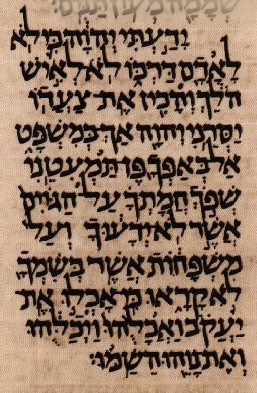
| Bible Research > Hebrew Text > Aleppo Codex |

The Aleppo Codex is an especially valuable witness to the early Masoretic textual tradition associated with Rabbi Aaron Ben Asher, a famous grammarian and scribe of the tenth century. It was written around A.D. 920 in Palestine, probably in the vicinity of Tiberias, where Jewish scholars developed the system of vowel pointing which was to become the standard Masoretic system of vocalization. It is believed that Aaron Ben Asher himself penned the vowel points and the marginal Masorah (a system of comments cross-referencing the spelling and the occurrence of particular words) in this manuscript. It received the name of "Aleppo Codex" because for about five centuries it was kept in the synagogue in Aleppo, northern Syria. Prior to this it had been in Cairo (Egypt) for a time, where it was apparently used as a model by the famous medieval Jewish scholar Maimonides. The codex was used as a model for the correct pointing, paragraphing and formatting of the text, as Maimonides states:
"In these matters we relied upon the codex, now in Egypt, which contains the twenty-four books of Scripture and which had been in Jerusalem for several years. It was used as the standard text in the correction of books. Everyone relied on it, because it had been corrected by Ben Asher himself who worked on its details closely for many years and corrected it many times whenever it was being copied." (Emanuel Tov, Textual Criticism of the Hebrew Bible [Minneapolis: Fortress Press, 2001], p. 46).
Up until the middle of the twentieth century the codex remained in good condition. It was the oldest known copy of the complete Hebrew Bible, and was generally acknowledged to be the most important Hebrew manuscript in existence. But at that time the manuscript was not in a safe place. The rise of modern Arab nationalism in the early part of the century led to civil unrest, and the Jewish synagogues of Syria were in some danger of violence. Unfortunately the Rabbis of Aleppo ignored pleas from scholars to move the manuscript to a place more secure than their synagogue. Worse yet, they refused to allow anyone to photograph the codex, and they became uncooperative with biblical scholars who wished to examine it. It appears that their motives in this were superstitious: they had come to believe that their exclusive possession of the manuscript would cause God to protect the Jewish community in Aleppo from all harm.
 In 1948 the synagogue in which the Aleppo Codex was kept was attacked and set on fire by rioters. The codex disappeared, and the Rabbis allowed the world to think that it had been destroyed in the fire. For ten years they tried to conceal the fact that the manuscript had been rescued from the fire, and that it remained in their possession. Their secret was made known to the Israeli government by informants who had witnessed the rescue of the manuscript, and a concerted campaign of pressure and persuasion was directed at them by the Israeli government, scholarly institutions, and Jewish organizations. An official letter issued in 1953 by the Sepharadic Chief Rabbi Ouziel admonished them to deliver the manuscript into the hands of Israeli officials. Finally they did give up the manuscript, or rather two-thirds of it. There has been no satisfactory account of what happened to the missing third, which includes most of the Pentateuch and some other portions. It has been reported that the missing sections were burnt, but this is doubtful, because none of the surviving sections show signs of fire damage. One missing leaf was turned over to the Jewish National Library in Jerusalem in December 1982 by a family of Jews who had moved from Aleppo to Brooklyn in the U.S.A.
In 1948 the synagogue in which the Aleppo Codex was kept was attacked and set on fire by rioters. The codex disappeared, and the Rabbis allowed the world to think that it had been destroyed in the fire. For ten years they tried to conceal the fact that the manuscript had been rescued from the fire, and that it remained in their possession. Their secret was made known to the Israeli government by informants who had witnessed the rescue of the manuscript, and a concerted campaign of pressure and persuasion was directed at them by the Israeli government, scholarly institutions, and Jewish organizations. An official letter issued in 1953 by the Sepharadic Chief Rabbi Ouziel admonished them to deliver the manuscript into the hands of Israeli officials. Finally they did give up the manuscript, or rather two-thirds of it. There has been no satisfactory account of what happened to the missing third, which includes most of the Pentateuch and some other portions. It has been reported that the missing sections were burnt, but this is doubtful, because none of the surviving sections show signs of fire damage. One missing leaf was turned over to the Jewish National Library in Jerusalem in December 1982 by a family of Jews who had moved from Aleppo to Brooklyn in the U.S.A.
Samples of the text of the Aleppo codex are given at the top of this page (Jeremiah 10:23-25) and on another page of this site which gives an entire column from Isaiah chapter 9.

| Bible Research > Hebrew Text > Aleppo Codex |